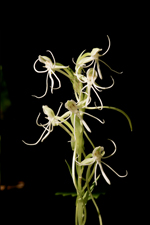Long-horned false rein orchid (Habenaria macroceratitis)
Part of the Florida's Native and Naturalized Orchids Website
Classification:Kingdom: Plantae - Plants
Subkingdom: Tracheobionta - Vascular Plants
Superdivision: Spermatophyta - Seed plants
Division: Magnoliophyta - Flowering plants
Class: Liliopsida - Monocotyledons
Subclass: Liliidae - Lily/related subclass
Order: Orchidales - Orchid order
Family: Orchidaceae - Orchid Family
Subfamily: Orchidiodeae -
Tribe: Orchideae - Orchidoids.
Subtribe: Orchidinae - Orchis and related.
|
Distribution Map: |
Description: Synonyms: Habenaria quinqueseta v. macroceratitis Summary: Erect, terrestrial herbs with medium-green leaves. Seedlings form a basal rosette flush against the ground. Mature plants with leaves ascending up the stem. Spidery white-green flowers with long nectaries/spurs descending from the back. Common Name: Long-horned false rein orchid Habitat: hardwood hammocks Flowering season: August through October (peaking in September) |
Images:
Description:
This species is much less common than the related Habenaria quinqueseta, only being known from a few counties in central Florida. Where the two coexist, this species seems to bloom a week or two earlier.
The plants and flowers of this species also strongly resemble H. quinqueseta. Perhaps the most striking characteristic is the long spur/nectary on the back of the flower. With H. quinqueseta, this spur tends to be less than four inches (10cm) long. With H. macroceratitis, this length is upwards of four inches (10cm) in length. The particular colony I visited had spur lengths of over six inches (15cm).
There is some debate over whether this is a separate species, a recognized variety of H. quinqueseta, or something not even deserving varietal designation. Paul Martin Brown's book, Wild Orchids of Florida, maintains this as a separate species, while the online Kew Monocot Checklist and the Florida Vascular Plant Atlas maintain the idea that these are synonymous. This guide will continue to list these as separate species while the debate rages on.
Copyright © 2009-2020 Prem Subrahmanyam, All Rights Reserved.
No Text or Images from this web site may be used, in whole or in part, without the express permission of the author.
For further information, see the Terms of Use page.








